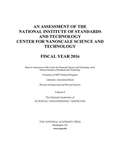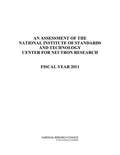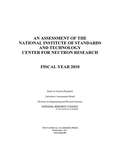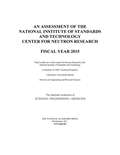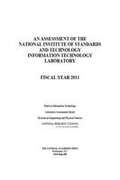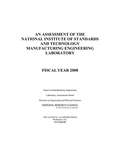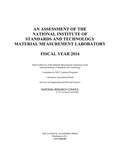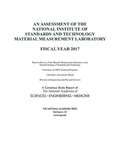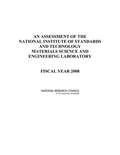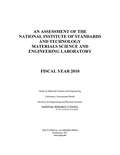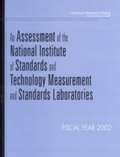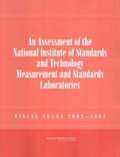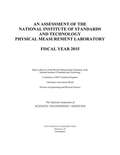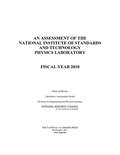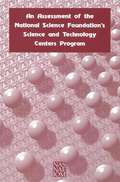- Table View
- List View
An Assessment of the National Institute of Standards and Technology Center for Nanoscale Science and Technology: Fiscal Year 2011
by Technology Panel on Nanoscale ScienceSince 1959, the National Research Council (NRC), at the request of the National Institute of Standards and Technology (NIST), has annually assembled panels of experts to assess the quality and effectiveness of the NIST measurements and standards laboratories. In 2011, the NRC evaluated three of the six NIST laboratories: the Center for Nanoscale Science and Technology (CNST), the NIST Center for Neutron Research (NCNR) and the Information Technology Laboratory (ITL). Each of these was addressed individually by a separate panel of experts; this report assesses CNST.
An Assessment of the National Institute of Standards and Technology Center for Nanoscale Science and Technology: Fiscal Year 2016
by Engineering Medicine National Academies of SciencesAt the request of the National Institute of Standards and Technology (NIST), the National Academies of Sciences, Engineering, and Medicine has, since 1959, annually assembled panels of experts from academia, industry, medicine, and other scientific and engineering communities to assess the quality and effectiveness of the NIST measurements and standards laboratories, of which there are now seven, as well as the adequacy of the laboratories’ resources. An Assessment of the National Institute of Standards and Technology Center for Nanoscale Science and Technology: Fiscal Year 2016 assesses the scientific and technical work performed by the NIST Center for Nanoscale Science and Technology and the accomplisments, challenges, and opportunities for improvement.
An Assessment of the National Institute of Standards and Technology Center for Neutron Research
by National Research Council Panel on Neutron ResearchThe National Institute of Standards and Technology [NIST] Center for Neutron Research (NCNR) is a national user facility whose mission is to ensure the availability of neutron measurement capabilities in order to meet the needs of U.S. researchers from industry, academia, and government agencies.<P><P> This mission is aligned with the mission of NIST, which is to promote U.S. innovation and industrial competitiveness by advancing measurement science, standards, and technology in ways that enhance economic security and improve the quality of life.
An Assessment of the National Institute of Standards and Technology Center for Neutron Research
by The National Academy of SciencesSince 1959, the National Research Council (NRC), at the request of the National Institute of Standards and Technology (NIST), has annually assembled panels of experts to assess the quality and effectiveness of the NIST measurements and standards laboratories. In 2011, the NRC evaluated three of the six NIST laboratories: the Center for Nanoscale Science and Technology (CNST), the NIST Center for Neutron Research (NCNR) and the Information Technology Laboratory (ITL). Each of these was addressed individually by a separate panel of experts; this report assesses NCNR.
An Assessment of the National Institute of Standards and Technology Center for Neutron Research: Fiscal Year 2010
by National Research Council of the National AcademiesThe National Institute of Standards and Technology (NIST) Center for Neutron Research (NCNR) is a national user facility whose mission is to ensure the availability of neutron measurement capabilities in order to meet the needs of U.S. researchers from industry, academia, and government agencies. This mission is aligned with the mission of NIST, which is to promote U.S. innovation and industrial competitiveness by advancing measurement science, standards, and technology in ways that enhance economic security and improve the quality of life. As requested by the Deputy Director of NIST, this book assesses NCNR, based on the following criteria: (1) the technical merit of the current laboratory programs relative to current state-of-the-art programs worldwide; (2) the adequacy of the laboratory budget, facilities, equipment, and human resources, as they affect the quality of the laboratory technical programs; and (3) the degree to which the laboratory programs in measurement science and standards achieve their stated objectives and desired impact.
An Assessment of the National Institute of Standards and Technology Center for Neutron Research: Fiscal Year 2013
by National Research Council of the National AcademiesThe National Institute of Standards and Technology (NIST) Center for Neutron Research (NCNR), with its strong tradition of hiring and developing excellent scientific and technical staff, is one of the leading institutions worldwide in neutron instrumentation, technology, and science. It is a very well-managed user facility. With the recent completion of a $95 million expansion, performed on time and on budget, it has enhanced its instrumentation capabilities and has constructed a new guide hall. This expansion further enhances NCNR’s ability to meet high user demands—a factor of two higher than capacity—for experimentation to conduct cutting-edge research. NCNR’s high scientific productivity is due, in part, to effective communication between the management and staff and with the internal and external user communities. <P> To continue to respond effectively to a changing environment and opportunities afforded by the recent reorganization of NIST, the NCNR management should pay particular attention to the considerations below to ensure that the NCNR continues to effectively serve its mission. <P><P> NCNR management has historically done an excellent job at short-term, tactical planning. The NIST reorganization now provides them with an opportunity to operate more strategically. Because in the near future some of the more senior scientific and technical staff will be retiring, formalized succession planning needs to be performed in coordination with the broader NIST management.
An Assessment of the National Institute of Standards and Technology Center for Neutron Research: Fiscal Year 2015
by Technology Panel on Review of the Center for Neutron Research at the National Institute of StandardsAt the request of the National Institute of Standards and Technology (NIST), the National Academies of Sciences, Engineering, and Medicine has, since 1959 annually assembled panels of experts from academia, industry, medicine, and other scientific and engineering environments to assess the quality and effectiveness of the NIST measurements and standards laboratories, of which there are now seven, as well as the adequacy of the laboratories’ resources. An Assessment of the National Institute of Standards and Technology Center for Neutron Research: Fiscal Year 2015 reviews the organization's technical programs, the portfolio of scientific expertise within the organization, the adequacy of the organization's facilities, equipment, and human resources, and the effectiveness with which the organization disseminates its program outputs.
An Assessment of the National Institute of Standards and Technology Center for Neutron Research: Fiscal Year 2023
by Division on Engineering and Physical Sciences Laboratory Assessments Board National Academies of Sciences, Engineering, and Medicine Panel on the Assessment of the National Institute of Standards and Technology (NIST) Center for Neutron ResearchSince 1959, the National Institute of Standards and Technology (NIST) has annually enlisted the National Academies of Sciences, Engineering, and Medicine to convene expert panels comprising individuals from academia, industry, and various scientific and engineering fields. Their primary task is to evaluate the quality and efficacy of the six NIST measurements and standards laboratories, as well as the sufficiency of resources available to these laboratories. This report assesses the NIST Center for Neutron Research (NCNR), with a focus on scientific and technical programs; portfolio of scientific and technical expertise; the adequacy of the budget, facilities, instrumentation, and human resources; and the effectiveness of NCNR dissemination efforts.
An Assessment of the National Institute of Standards and Technology Engineering Laboratory: Fiscal Year 2014
by Technology Panel on Review of the Engineering Laboratory at the National Institute of StandardsThe mission of the Engineering Laboratory of the National Institute of Standards and Technology (NIST) is to promote U. S. innovation and industrial competitiveness through measurement science and standards for technology-intensive manufacturing, construction, and cyberphysical systems in ways that enhance economic prosperity and improve the quality of life. To support this mission, the Engineering Laboratory has developed thrusts in smart manufacturing, construction, and cyberphysical systems; in sustainable and energy-efficient manufacturing materials and infrastructure; and in disaster-resilient buildings, infrastructure, and communities. The technical work of the Engineering Laboratory is performed in five divisions: Intelligent Systems; Materials and Structural Systems; Energy and Environment; Systems Integration; and Fire Research; and two offices: Applied Economics Office and Smart Grid Program Office. An Assessment of the National Institute of Standards and Technology Engineering Laboratory Fiscal Year 2014 assesses the scientific and technical work performed by the NIST Engineering Laboratory. This report evaluates the organization's technical programs, portfolio of scientific expertise within the organization, adequacy of the organization's facilities, equipment, and human resources, and the effectiveness by which the organization disseminates its program outputs.
An Assessment of the National Institute of Standards and Technology Information Technology Laboratory: Fiscal Year 2011
by Panel on Information TechnologySince 1959, the National Research Council (NRC), at the request of the National Institute of Standards and Technology (NIST), has annually assembled panels of experts to assess the quality and effectiveness of the NIST measurements and standards laboratories. In 2011, the NRC evaluated three of the six NIST laboratories: the Center for Nanoscale Science and Technology (CNST), the NIST Center for Neutron Research (NCNR) and the Information Technology Laboratory (ITL). Each of these was addressed individually by a separate panel of experts; this report assesses ITL.
An Assessment of the National Institute of Standards and Technology Manufacturing Engineering Laboratory
by National Research Council Division on Engineering and Physical Sciences Laboratory Assessments Board Panel on Manufacturing EngineeringThe mission of the Manufacturing Engineering Laboratory (MEL) of the National Institute of Standards and Technology (NIST) is to promote innovation and the competitiveness of U.S. manufacturing through measurement science, measurement services, and critical technical contributions to standards. The MEL is organized in five divisions: Intelligent Systems, Manufacturing Metrology, Manufacturing Systems Integration, Precision Engineering, and Fabrication Technology. A panel of experts appointed by the National Research Council (NRC) assessed the first four divisions. Overall, this book finds that the four individual divisions are performing to the best of their ability, given available resources. In many areas in all four divisions, the capabilities and the work being performed are among the best in the field. However, reduced funding and other factors such as difficulty in hiring permanent staff are limiting (and are likely to increasingly limit) the degree to which MEL programs can achieve their objectives and are threatening the future impact of these programs.
An Assessment of the National Institute of Standards and Technology Manufacturing Engineering Laboratory: Fiscal Year 2010
by National Research Council of the National AcademiesThe mission of the Manufacturing Engineering Laboratory (MEL) of the National Institute of Standards and Technology (NIST) is to promote innovation and the competitiveness of U.S. manufacturing through measurement science, measurement services, and critical technical contributions to standards. The MEL is organized in five divisions: Intelligent Systems, Manufacturing Metrology, Manufacturing Systems Integration, Precision Engineering, and Fabrication Technology. A panel of experts appointed by the National Research Council (NRC) assessed the first four divisions.
An Assessment of the National Institute of Standards and Technology Material Measurement Laboratory: Fiscal Year 2014
by Technology Panel on Review of the Material Measurement Laboratory at the National Institute of StandardsThe National Institute of Standards and Technology's (NIST's) Material Measurement Laboratory (MML) is our nation's reference laboratory for measurements in the chemical, biological, and materials sciences and engineering. Staff of the MML develop state-of-the-art measurement techniques and conduct fundamental research related to measuring the composition, structure, and properties of substances. Tools that include reference materials, data, and measurement services are developed to support industries that range from transportation to biotechnology and to address problems such as climate change, environmental sciences, renewable energy, health care, infrastructure, food safety and nutrition, and forensics. This report assesses the scientific and technical work performed by NIST's Material Measurement Laboratory. In particular, the report assesses the organization's technical programs, the portfolio of scientific expertise within the organization, the adequacy of the organization\'s facilities, equipment, and human resources, and the effectiveness by which the organization disseminates its program outputs.
An Assessment of the National Institute of Standards and Technology Material Measurement Laboratory: Fiscal Year 2017
by Engineering Medicine National Academies of SciencesAn Assessment of the National Institute of Standards and Technology Material Measurement Laboratory: Fiscal Year 2017 assesses the scientific and technical work performed by the National Institute of Standards (NIST). This publication reviews technical reports and technical program descriptions prepared by NIST staff summarizes the findings of the authoring panel.
An Assessment of the National Institute of Standards and Technology Materials Science and Engineering Laboratory
by National Research Council Division on Engineering and Physical Sciences Laboratory Assessments Board Panel on Materials Science and EngineeringThe Materials Science and Engineering Laboratory (MSEL) of the National Institute of Standards and Technology (NIST) works with industry, standards bodies, universities, and other government laboratories to improve the nation's measurements and standards infrastructure for materials. A panel of experts appointed by the National Research Council (NRC) assessed the four divisions of MSEL, by visiting these divisions and reviewing their activities. This book concludes that, for the selected portion of the MSEL programs reviewed, the staff, the projects, and many facilities are outstanding. The projects are clearly focused on the mission of MSEL. The facilities and equipment are rationally upgraded within budget constraints, with several facilities being unique; the funding provided through the America COMPETES Act of 2007 is being used effectively. Division chiefs and staff evinced high morale, attributable to several factors: clear definitions of expectations and of the processes for realizing them, strong support of the MSEL from NIST leadership and of NIST generally from the President and from the Congress (through the American Competitiveness Initiative and the America COMPETES Act), and positive feedback from customers.
An Assessment of the National Institute of Standards and Technology Materials Science and Engineering Laboratory: Fiscal Year 2010
by National Research Council of the National AcademiesThe Materials Science and Engineering Laboratory (MSEL) of the National Institute of Standards and Technology (NIST) works with industry, standards bodies, universities, and other government laboratories to improve the nation's measurements and standards infrastructure for materials. A panel of experts appointed by the National Research Council (NRC) assessed the four divisions of MSEL, by visiting these divisions and reviewing their activities.
An Assessment of the National Institute of Standards and Technology Measurement and Standards Laboratories: FISCAL YEAR 2002
by National Academy of Science the National AcademiesThe National Academies Press (NAP)--publisher for the National Academies--publishes more than 200 books a year offering the most authoritative views, definitive information, and groundbreaking recommendations on a wide range of topics in science, engineering, and health.<P><P> Our books are unique in that they are authored by the nation's leading experts in every scientific field.
An Assessment of the National Institute of Standards and Technology Measurement and Standards Laboratories: FISCAL YEARS 2004 - 2005
by National Research Council of the National AcademiesThe National Institute of Standards and Technology (NIST) Measurements and Standards Laboratories (MSL) provide technical leadership for the nation’s measurement and standards infrastructure and assure the availability of essential reference data and measurement capabilities. <P><P>At NIST’s request the National Research Council (NRC) carries out a biennial assessment of the seven MSL. The assessment focuses on each laboratory’s technical quality and merit; and effectiveness. It also examines the relevance of the NIST programs and how well laboratory facilities, equipment, and personnel are able to fulfill the MSL mission. This report presents an overall assessment of the MSL followed by detailed assessments of each of the seven laboratories.
An Assessment of the National Institute of Standards and Technology Physical Measurement Laboratory: Fiscal Year 2015
by Engineering Medicine National Academies of SciencesThe Physical Measurement Laboratory (PML) at the National Institute of Standards and Technology (NIST) is dedicated to three fundamental and complementary tasks: (1) increase the accuracy of our knowledge of the physical parameters that are the foundation of our technology-driven society; (2) disseminate technologies by which these physical parameters can be accessed in a standardized way by the stakeholders; and (3) conduct research at both fundamental and applied levels to provide knowledge that may eventually lead to advances in measurement approaches and standards. This report assesses the scientific and technical work performed by the PML and identifies salient examples of accomplishments, challenges, and opportunities for improvement for each of its nine divisions.
An Assessment of the National Institute of Standards and Technology Physics Laboratory
by National Research Council Division on Engineering and Physical Sciences Laboratory Assessments Board Panel On PhysicsThe mission of the NIST Physics Laboratory is to support U.S. industry, government, and the scientific community by providing measurement services and research for electronic, optical, and radiation technology. In this respect, the laboratory provides the foundation for the metrology of optical and ionizing radiations, time and frequency, and fundamental quantum processes, historically major areas of standards and technology. The Panel on Physics visited the six divisions of the laboratory and reviewed a selected sample of their programs and projects. This book finds that the overall quality and productivity of the Physics Laboratory are comparable to or better than those of other peer institutions, an accomplishment that is being achieved with an infrastructure that is smaller in both size and funding than the size and funding of most national and agency laboratories in the United States.
An Assessment of the National Institute of Standards and Technology Physics Laboratory: Fiscal Year 2010
by National Research Council of the National AcademiesThe mission of the National Institute of Standards and Technology (NIST) Physics Laboratory is to support U.S. industry, government, and the scientific community by providing measurement services and research for electronic, optical, and radiation technology. In this respect, the laboratory provides the foundation for the metrology of optical and ionizing radiations, time and frequency, and fundamental quantum processes, historically major areas of standards and technology. The Panel on Physics visited the six divisions of the laboratory and reviewed a selected sample of their programs and projects.
An Assessment of the National Science Foundation's Science and Technology Centers Program
by Committee on Science Engineering Public PolicyAn Assessment of the National Science Foundation's Science and Technology Centers Program
An Assessment of the Need for Native Seeds and the Capacity for Their Supply: Interim Report
by Committee on National Statistics Board on Agriculture and Natural Resources Division of Behavioral and Social Sciences and Education Division on Earth and Life Studies National Academies of Sciences, Engineering, and Medicine Committee on an Assessment of Native Seed Needs and CapacitiesAcross the United States, millions of acres of land have been so disturbed by human activities or severe climate events that significant portions of their native plant communities have been lost and their ecosystems have been seriously compromised. Restoring impaired ecosystems requires a supply of diverse native plant seeds that are well suited to the climates, soils, and other living species of the system. Native seeds are also in demand for applications in urban land management, roadside maintenance, conservation agriculture, and other restorative activities that take into account the connection between native plant communities and the increasingly urgent need for resilient landscapes. Given the varied climatic and environmental niches of the more than 17,000 native plant species of the United States, supplying the desired seed types and species mixes for this wide range of activities is a challenge. As the first phase of a nationwide analysis of the full scope of needs for native plant seeds, this interim report describes the participants in the native plant seed supply chain, makes preliminary observations, and proposes an information-gathering plan for the second phase of the assessment.
An Assessment of the Prospects for Inertial Fusion Energy
by National Research Council Division on Engineering and Physical Sciences Board on Physics and Astronomy Board on Energy and Environmental Systems Committee on the Prospects for Inertial Confinement Fusion Energy SystemsThe potential for using fusion energy to produce commercial electric power was first explored in the 1950s. Harnessing fusion energy offers the prospect of a nearly carbon-free energy source with a virtually unlimited supply of fuel. Unlike nuclear fission plants, appropriately designed fusion power plants would not produce the large amounts of high-level nuclear waste that requires long-term disposal. Due to these prospects, many nations have initiated research and development (R&D) programs aimed at developing fusion as an energy source. Two R&D approaches are being explored: magnetic fusion energy (MFE) and inertial fusion energy (IFE). An Assessment of the Prospects for Inertial Fusion Energy describes and assesses the current status of IFE research in the United States; compares the various technical approaches to IFE; and identifies the scientific and engineering challenges associated with developing inertial confinement fusion (ICF) in particular as an energy source. It also provides guidance on an R&D roadmap at the conceptual level for a national program focusing on the design and construction of an inertial fusion energy demonstration plant.
An Assessment of the SBIR Program at the Department of Defense
by National Research Council of the National AcademiesThe SBIR program allocates 2.5 percent of 11 federal agencies' extramural R&D budgets to fund R&D projects by small businesses, providing approximately $2 billion annually in competitive awards. At the request of Congress, the National Academies conducted a comprehensive study of how the SBIR program has stimulated technological innovation and used small businesses to meet federal research and development needs. Drawing substantially on new data collection, this book examines the SBIR program at the Department of Defense and makes recommendations for improvements. Separate reports will assess the SBIR program at NSF, NIH, DOE, and NASA, respectively, along with a comprehensive report on the entire program.

